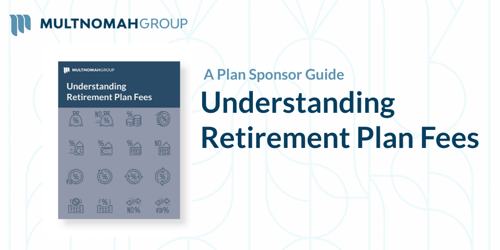When discussing retirement plan fees, recordkeeping expenses are usually the primary focus for plan fiduciaries. The reasons for this are two-fold. First, recordkeeping expenses are among the largest expenses incurred by a plan, second only to investment management fees for most plans. For smaller plans, recordkeeping expenses maybe even the largest single expense incurred by the plan.
Second, recordkeeping fees are the most confusing fees paid by a plan. The retirement plan industry has spent far too many years playing games with these fees in an effort to obfuscate the cost of a plan. While fee transparency has increased, industry pricing models still vary widely, and transparency is not consistent across all providers and fee types. As a result, determining what fees are paid for recordkeeping services still requires a fair amount of detective work and industry knowledge.
As we consider recordkeeping fees, we think it is important to understand the fees through two separate, distinct lenses.
1. What are the “recordkeeping” services that we are paying for?
2. How are we paying for these services?
In this blog, we are going to walk through the first part of understanding recordkeeping fees.
Recordkeeping Services
Recordkeeping fees broadly encompass four separate services:
- Plan recordkeeping
- Plan administration and compliance
- Custody of plan assets
- Participant communication and education services
Plan Recordkeeping
Plan recordkeeping encompasses the core services that most consider when they think of retirement plan recordkeeping. Recordkeeping involves tracking participants’ account balances within the plan, processing contributions into the plan, investing those contributions based on participants’ investment elections, and processing withdrawal activity from the plan such as loans or distributions. The recordkeeping vendor also provides the participant interface to the plan through their website and automated voice response system.
Plan Administration and Compliance
Most employer-sponsored retirement plans are subject to a wide variety of Internal Revenue Service (IRS) and Department of Labor (DOL) rules and regulations. The plan administration and compliance function should cover most of the work that is required for a plan to maintain compliance with IRS and DOL rules. Proper administration includes the annual compliance work that is required, gathering census data for the plan, performing required non-discrimination testing, and preparation of required documents such as the Form 5500.
In our experience, plan administration and compliance support services are frequently bundled with core recordkeeping services for most plans. Smaller, tax-driven plans or plans with unique benefit formulas may elect to de-couple the administration and compliance services from the recordkeeping by utilizing a third-party administrator (TPA) to perform this function.
Custody of Plan Assets
The custody of plan assets includes:
- the safekeeping of plan’s assets
- executing transactions within the plan based on instructions provided by the recordkeeper
- interfacing with the various investment products that are utilized within the plan
In most cases, the recordkeeper keeps track of individual participant balances within each fund for a plan while the custodian holds a single account for all of the plan’s assets invested in that fund.
Custody services are most frequently bundled with core recordkeeping services. Some recordkeeping organizations may utilize the services of a third-party custodian. In those instances, the plan sponsor rarely interacts directly with the third-party custodian but almost always interacts with the recordkeeping vendor who provides direction to the custodian. Large and mega plans may also elect to de-couple custody services from recordkeeping services. This is typically done when there are more complicated custody requirements such as separate account unitization, white label investments, employer stock, or master trust covering multiple plans.
Participant Communication and Education Services
In an effort to improve retirement outcomes, plan fiduciaries typically elect to offer participant education and/or advice services as part of their retirement program. These services may include customized employee communications such as emails or newsletters, group participant education, or individual participant advice sessions. Usually, these services are provided by the recordkeeping vendor, but some plans may elect to work with an outside investment advisor to provide employee education or with a third-party communications provider to develop customized employee communication materials.
More to come!
Be on the lookout for the next blog on this topic focused on the second part of recordkeeping fees to understand, which is "how are you paying for these services?"

Understanding the fees and expenses associated with a retirement plan is a requirement for plan fiduciaries as part of their duty to ensure the costs associated with their plan are fair and reasonable in light of the services rendered. Our full guide on retirement plan fees provides a thorough overview of the categories of retirement plan fees and the specific services typically related to each expense for plan fiduciaries. Download the guide here.
Multnomah Group is a registered investment adviser, registered with the Securities and Exchange Commission. Any information contained herein or on Multnomah Group’s website is provided for educational purposes only and does not intend to make an offer or solicitation for the sale or purchase of any specific securities, investments, or investment strategies. Investments involve risk and, unless otherwise stated, are not guaranteed. Multnomah Group does not provide legal or tax advice.

